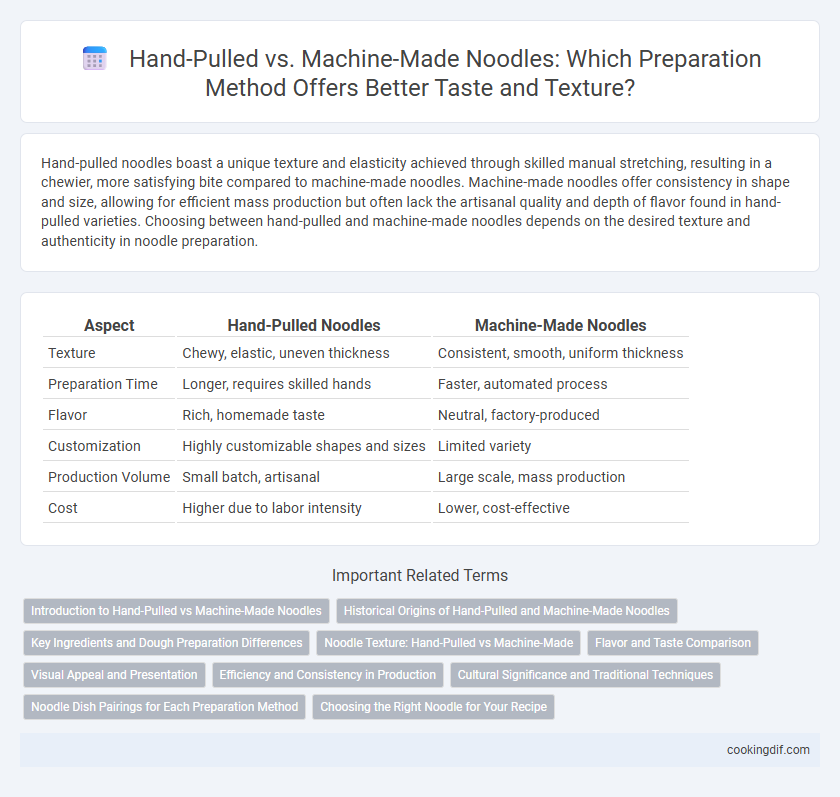Hand-pulled noodles boast a unique texture and elasticity achieved through skilled manual stretching, resulting in a chewier, more satisfying bite compared to machine-made noodles. Machine-made noodles offer consistency in shape and size, allowing for efficient mass production but often lack the artisanal quality and depth of flavor found in hand-pulled varieties. Choosing between hand-pulled and machine-made noodles depends on the desired texture and authenticity in noodle preparation.
Table of Comparison
| Aspect | Hand-Pulled Noodles | Machine-Made Noodles |
|---|---|---|
| Texture | Chewy, elastic, uneven thickness | Consistent, smooth, uniform thickness |
| Preparation Time | Longer, requires skilled hands | Faster, automated process |
| Flavor | Rich, homemade taste | Neutral, factory-produced |
| Customization | Highly customizable shapes and sizes | Limited variety |
| Production Volume | Small batch, artisanal | Large scale, mass production |
| Cost | Higher due to labor intensity | Lower, cost-effective |
Introduction to Hand-Pulled vs Machine-Made Noodles
Hand-pulled noodles are crafted by expertly stretching and folding the dough to create a chewy texture and irregular thickness, offering a traditional taste and artisanal quality. Machine-made noodles provide consistent size and texture through automated extrusion, allowing for mass production and uniformity in commercial settings. The choice between hand-pulled and machine-made noodles significantly affects the noodle's texture, flavor complexity, and overall dining experience.
Historical Origins of Hand-Pulled and Machine-Made Noodles
Hand-pulled noodles trace their origins to China's Tang Dynasty, exemplifying artisanal craftsmanship with dough stretched by skilled hands to create irregular, textured strands. Machine-made noodles emerged during the Industrial Revolution, revolutionizing production with uniformity and mass output, particularly in urban markets worldwide. The historical development of these methods reflects cultural values and technological advancements shaping noodle consumption globally.
Key Ingredients and Dough Preparation Differences
Hand-pulled noodles rely on simple ingredients like high-gluten wheat flour, water, and salt, with dough firmness crucial for elasticity and stretchability. Machine-made noodles often incorporate additives such as kansui or alkali salts to enhance texture and color, with dough mixed uniformly for consistent thickness. The manual kneading and stretching in hand-pulled preparation develop gluten networks differently from mechanically rolled and cut dough, resulting in distinct texture and mouthfeel.
Noodle Texture: Hand-Pulled vs Machine-Made
Hand-pulled noodles exhibit a unique chewy texture due to the stretching and folding process that aligns gluten strands, resulting in a springy bite. Machine-made noodles often have a consistent thickness and a smoother surface, but their texture tends to be denser and less elastic compared to hand-pulled varieties. The artisanal technique of hand-pulling enhances noodle texture by creating irregularities that improve sauce absorption and mouthfeel.
Flavor and Taste Comparison
Hand-pulled noodles offer a chewier texture and a more complex, slightly rustic flavor due to the uneven thickness and elasticity achieved by manual stretching. Machine-made noodles provide a consistent texture and uniform cooking but often lack the nuanced flavor variations found in hand-pulled noodles. The artisanal process of hand-pulling enhances the noodle's ability to absorb sauces, resulting in a richer, more intense taste experience.
Visual Appeal and Presentation
Hand-pulled noodles showcase unique irregularities and varying thicknesses that create a rustic, artisanal visual appeal often prized in traditional dishes. Machine-made noodles offer uniformity in shape and size, resulting in a consistent, polished presentation ideal for mass production and standardized plating. The contrasting textures and symmetrical precision of machine-made noodles enhance modern culinary aesthetics, while hand-pulled noodles highlight craftsmanship and authenticity.
Efficiency and Consistency in Production
Hand-pulled noodles offer artisanal texture and flavor but generally require more time and skilled labor, limiting large-scale efficiency. Machine-made noodles enable rapid, high-volume production with consistent size and quality, essential for meeting industrial demand. Automated processes reduce human error and variability, ensuring uniform texture and faster turnaround in commercial noodle manufacturing.
Cultural Significance and Traditional Techniques
Hand-pulled noodles embody centuries-old cultural traditions, showcasing skilled craftsmanship through the artisanal process of stretching and folding dough by hand, which preserves unique texture and flavor essential to regional cuisines. Machine-made noodles offer efficiency and consistency but often lack the nuanced elasticity and chewiness imparted by traditional techniques central to culinary heritage. The preservation of hand-pulled noodle methods is vital for maintaining cultural identity and gastronomic authenticity within communities.
Noodle Dish Pairings for Each Preparation Method
Hand-pulled noodles pair exceptionally well with rich, hearty broths such as beef or lamb stew, enhancing their chewy texture and absorbing deep flavors. Machine-made noodles complement lighter sauces and stir-fries, maintaining their consistent shape and firmness for dishes like sesame noodles or cold noodle salads. Selecting the appropriate noodle type can elevate the dining experience by matching texture and flavor profiles to the dish.
Choosing the Right Noodle for Your Recipe
Hand-pulled noodles offer a chewy texture and irregular thickness that enhances the authenticity of traditional Asian dishes, while machine-made noodles provide consistent shape and faster production ideal for mass cooking. Selecting the right noodle depends on the recipe's requirements for texture, cooking time, and flavor absorption. Fresh hand-pulled noodles suit hearty soups and stir-fries, whereas machine-made noodles excel in quick, uniform dishes like ramen or lo mein.
hand-pulled vs machine-made for noodle preparation Infographic

 cookingdif.com
cookingdif.com